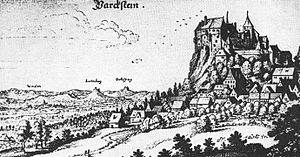Parkstein Castle
| Parkstein castle ruins | ||
|---|---|---|
|
Parkstein castle and place around 1630, copperplate engraving by Matthäus Merian |
||
| Creation time : | around 1000 | |
| Castle type : | Höhenburg in spur location | |
| Conservation status: | A few remains of the wall and the remains of two roundels in the former lower courtyard | |
| Standing position : | Unknown | |
| Construction: | Basalt quarry stones | |
| Place: | Park stone | |
| Geographical location | 49 ° 43 '55 " N , 12 ° 4' 12" E | |
| Height: | 595 m above sea level NN | |
|
|
||
The Castle Park Stein was once one of the largest castles of the Upper Palatinate and stood on the top of the basalt cone Parkstein after the surrounding village .
history
According to legend, an imperial hunting party became aware of the beautiful basalt cone while chasing a boar, so that one of the hunt participants decided to build a spur castle there. As can be seen on a copper engraving by Matthäus Merian from 1644 (see overview panel), the castle that once existed here was one of the largest in the Nordgau . In documents is already in 1052 by the cremation of the Veste Park Stone's speech.
After the reconstruction, the Counts of Sulzbach lived in this castle, their ministerials as Lords of Parkstein. Further owners were then in the 12th century Friedrich Barbarossa and from 1251 Duke Otto II of Bavaria. The imperial city of Nuremberg , Bohemia , the Leuchtenbergers and finally the Wittelsbachers again followed .
From 1421 to 1714, as a result of the Bavarian War, there was a condominium between the Electorate of Brandenburg and the Electoral Palatinate , the Parkstein-Weiden community office . The Brandenburg share came to the Duchy of Pfalz-Neuburg in 1505 and became part of Pfalz-Sulzbach in 1615 . In 1623 Wolfgang Wilhelm von Pfalz-Neuburg again acquired the Palatinate share. In the course of the Thirty Years' War the castle fell into disrepair. In 1714 Pfalz-Neuburg sold its share to Pfalz-Sulzbach, the condominium was thus ended.
The fortified castle was demolished in the middle of the 18th century. Among other things, the tower of the parish church of Weiden was built in 1756 from ashlar stones from the powder tower , and after 1835 the recently burned down town of Parkstein was rebuilt from the remains of the fortress, which were still considerable until then. Today there are only a few sparse remains on the steep slope of the basalt cone. Today, instead of the castle, there is a chapel (built in 1851) on the summit.
literature
- Ursula Pfistermeister : Castles of the Upper Palatinate . Verlag Friedrich Pustet, Regensburg 1974, ISBN 3-7917-0394-3 , p. 92.
- Bernhard Weigl : Parkstein Castle - A guide through one of the once most important fortresses in the Upper Palatinate . Verlag Eckhard Bodner, Pressath 2014, ISBN 978-3-939247-50-0 .
Web links
- Information on the website of the market town Parkstein (menu item "History")
- Chronicle and historical illustration of the castle
- Historical reconstruction drawing
A 3D reconstruction proposal of the fortress for the 18th century can be viewed at the following link:
Individual evidence
- ↑ Jochen Rösel: Parkstein-Weiden, community office , in: Historisches Lexikon Bayerns. (September 8, 2010)


